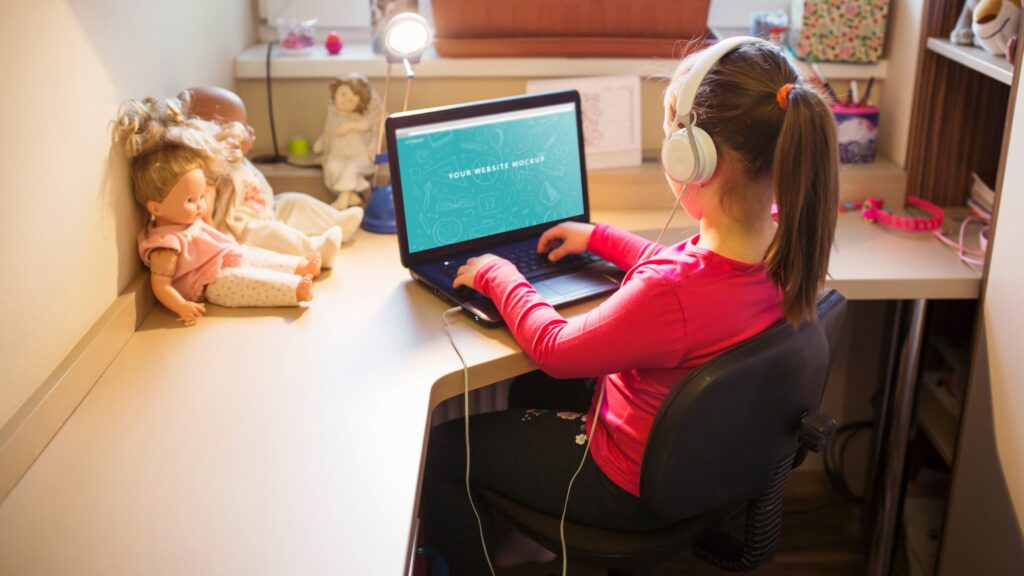
5 Tips for Helping Your Child with E-Learning
When the COVID-19 pandemic halted in-school instruction and forced Illinois students (and parents) to start remote learning, many families scrambled to put together adequate e-learning spaces for their children. Dining room tables became study spaces and parents had to remember what a linear equation was.
Now that we are fully in remote instruction, your family needs a more robust and sturdy e-learning space that won’t interfere with the rest of the family. This will keep them more focused and productive during their school day.
1. Set up an awesome workspace
Space may be an issue if your whole family is working and learning remotely. You can still create a workstation for your child to thrive and save space.
- Create a separate space for each child. You may not have a lot of room to separate them from the rest of the family, but a tall bookshelf or sheet hanging from the ceiling can work to block them off. If two kids are at the same dining table, you can hang the sheet over it as a divider or use a science project display board and some duct tape.
- Make sure they are comfortable. Kids are smaller than adults, obviously, so you need to adjust tables, desks and chairs to make sure they are comfortable for prolonged use. The proper ergonomic position puts their feet on the floor, elbows on the desk at a normal resting height and close to the table. This is almost impossible to achieve with normal furniture.
Use pillows and/or foam seat boosters on the bottom and back of the chair to raise your child up and nearer to the desk or table. Next, place a box under the chair so their feet can touch. This will help them be more attentive and comfortable during e-learning.
2. Stick to a schedule
Kids do best when on a schedule, so make sure you try to keep each school day the same. A lot of school systems keep kids to a schedule that mirrors a normal school day, which should help with this goal.
As a parent, maintaining a good before-school schedule will help your kid win the day. Make sure your kids are up in time to dress, eat breakfast and gather their school supplies for the day ahead. Similarly, it’s important to have post-school time for your child to gather themselves after the day. Be it a snack, a nap, or just 15 minutes where they can do whatever they want, this hard break from school will help them better switch to their role as your child.
3. Schedule time apart
After a day of parent and child working together, it can be hard to break the school relationship and transition to the parent relationship. A scheduled “alone time” for your child may be the thing they need to remember that mommy is mommy or daddy is daddy, not a frustrated stand-in tutor.
It’s important to give your child space and time for them to be alone with themselves, to do a hobby they enjoy and decompress after a stressful day learning remotely. Ideally, this would be the time they can go run around outside, play video games or read for fun immediately after the school day day ends. Alone time can also be in the evening, before they go to bed, or even during their lunchtime, so they can mentally escape school during the day.
This not only benefits them, but it also allows you to take care of your own mental health. As a parent, it’s important to remember that your mental health is important to lead the whole family. Make sure you are taking some time away each day as well… even if it’s a bath after everyone is in bed.
4. Ask questions about their assignments
By asking about their school day, and specifically their classes, you’ll foster a better relationship with them as your parent. Even if you’re guiding your child through the school day, you can take an interest in their experience.
Here are some questions you could ask your child:
By asking about their school day, and specifically their classes, you’ll foster a better relationship with them as your parent. Even if you’re guiding your child through the school day, you can take an interest in their experience.
Here are some questions you could ask your child:
- What was your favorite thing you learned about today?
- Which class/teacher is the best at remote teaching?
- What assignments do you need help with?
- Which classes are harder for you to learn through remote instruction?
- Did anything funny happen during a class today?
5. Provide breaks and snacks
Even though your child would have normally been in school all day, there were still scheduled breaks and transition times throughout their day. Work with your child’s school schedule to figure out when is best for them to take an extended break for playtime, no-screen time, or even snack time.
One advantage of learning at home is snack time. Your child will enjoy snacking options throughout the day like fresh fruit or vegetables, crackers, snack bars or even yogurt. Snacks will give their brains and bodies the energy to learn throughout the day. At Ivy League Kids, we supply snacks at each All Day Programming and Before and After School location to ensure our kids have the fuel they need to succeed in e-learning.
Give yourself some grace. Being both a full-time parent and a part-time tutor can be stressful for a parent, but also put a strain on the parent-child relationship. This is a new way of school for you and your kids and we are all trying our best, so give yourself a pat on the back!
Providing separate spaces for all family members working from home, sticking to a schedule that includes alone time for everyone, showing interest in schoolwork outside of school hours, and providing snacks throughout the day can set you and your child up for success during remote-learning times.

